Exploring Close to Home - Jenkinson Lake
/Hiking with our kids near Jenkinson Lake.
Read MoreJuly, 2023: I have switched to writing most of my blog posts on my original WordPress blog so access all the current news there and sign up on that site for email updates.
Hiking with our kids near Jenkinson Lake.
Read MoreHiking at China Camp State Park
Read MoreVisiting Rosie the Riveter/World War II Home Front NHP
Read MoreThe first lamb surprised me by being a week early.
Read MoreA collection of farm photos taken during the day’s tasks.
Read MoreI take photos thinking of sharing on the blog and then I never have time. Here is an accumulation of some from the last couple of weeks.

Patchwork Amara and Patchwork Bettylou, the two lambs that came from Georgia last summer.

Daffodils are here. I have a friend who has told me she doesn’t like daffodils because they are trying to be too cheery. (You know who you are.) I don’t agree with that, but I must say that every time I see a daffodil I think of that friend.

What time of year is this?

It is a little worrisome to see roses blooming already.

One of the chickens decided to use the bin where I throw baling twine to make a nest.

Another is using an open bale of straw.

Making compost. Dan turns this pile every so often. You can see the steam rising. The pile is warm inside. Soon we’ll need more moisture to keep it going.

Meridian Jasmine.

One of the things that has been keeping me busy is skirting fleeces and photographing them for the website. I have several listed but they aren’t live on the site yet. They will be soon. This is a coated fleece—look how long and clean it is!
A follow-up to the first shearing day post, including before and after photos of some of the sheep.
Read MoreShearing Day at Meridian Jacobs—we sheared over 80 Jacob sheep.
Read MoreIt feels like the night before Christmas! …All through the barn the sheep are waiting…The barn is organized. The tools are hung (where is that strike-out thing when you need it—I wanted to say stockings but cross it out) . The rams have been moved to the barn. The water is turned off (empty stomachs are better for shearing). ETC.

Dan did this job earlier in the week. The gate we used to have here didn’t fit the space and I had a panel wired up to stick out into the doorway a couple of feet. The reason is that when the gate swings open (towards me when taking this photo) it would stick out into the south doorway to go in and out of the barn. That is not very pracrtical. So Dan designed and made a folding gate.

Here is is in use. Clever, isn’t it?

Yesterday we went to a friend’s place just up the road to pick up her Jacob sheep and bring them here for shearing. There are 16 or 17 ewes and one ram. This is the ram, born in 2021.

The next few photos are some of her ewes. They weren’t crazy about getting their photos taken—or maybe it was about me being in the pen with them.

A couple of pretty ewe lambs.

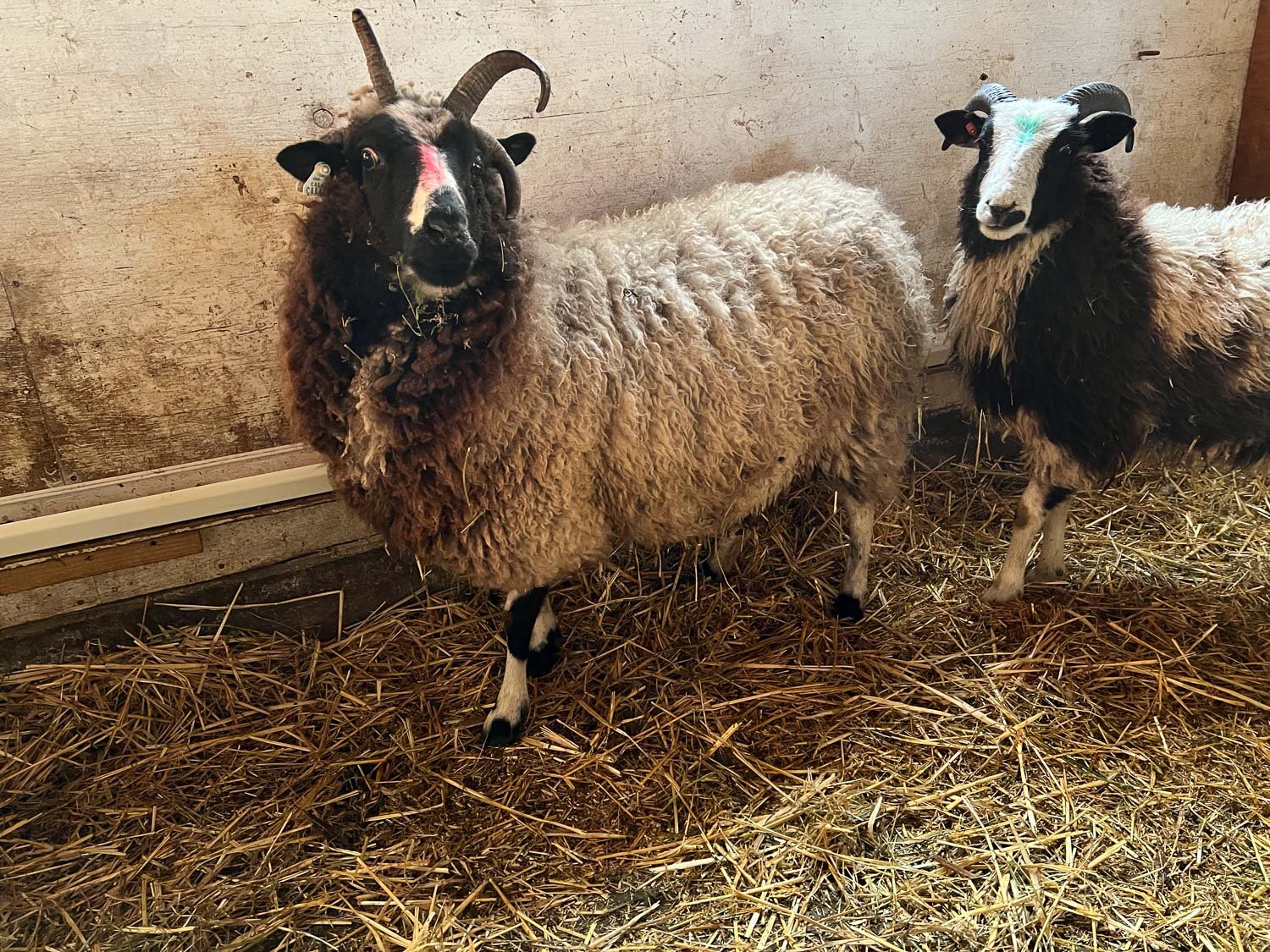
It will be fun to get hands-on these sheep and see their fleeces. We sheared them last year as well and they were a lot cleaner than mine as far as the vegetable matter goes—probably because they have winter pasture and are not being fed as much hay.

Tonight I brought my rams over to the barn so that I don’t have to deal with them in the morning. This is Rambler. He’s still a yearling—coming up on 2 years old in March.

Rambler’s fleece

Silverado (Ruby Peak Tamarisk x Meridian Spice), born almost a year ago in 2021.

Meridian Axis, a lilac ram also born in 2021. (Meridian Axle x Meridian Vixen)

Hillside Gabby’s Barrett, the ram lamb I got from the Hillside Farm in Michigan last summer. He is maturing nicely.

Barrett’s fleece.
Remember what I said about the Night Before Christmas? I’d better get to bed and read for awhile to turn my mind off so I can sleep. What’s that? Do I hear little hooves on the roof? Did I shut all the gates in the barn?
On a sunny January day experimented with my new iPhone camera while walking across the road.
Read MorePhotos of sheep and the story of why this group is named after nuts.
Read MoreI always like to get photos of all the sheep before shearing. I can go back and compare before and after shearing photos (which I find interesting) and I can find photos of some of the favorites as they have grown up. Yesterday I spent a ridiculous amount of time editing the sheep pages on the website to reflect which sheep are in the flock now. That included making sure I had photos of all the sheep—and I do have updated photos of almost all of them. You can view Our Ewes here and The Rams (and wethers) here.
When I post photos on those pages they are usually of the whole sheep, but I’ll include some close-up head shots here.

Meridian Cashew (Meridian Jasper x Meridian Dilly), born in 2020 and bred to Meridian Silverado. I love this ewe’s horns.

This is Dilly, the dam of Cashew, above. She will be 5 this spring.
I plan to start paying better attention to my ewes’ horn growth. A friend has focused on horns for quite awhile and she has a flock full of ewes with stunning horns. See PatchworkFarm.

Dilly is out of Honey, a ewe who also has nice horns. She will be 7 when she lambs this year.

I was thrilled to be able to bring in a couple of Patchwork ewe lambs last summer. This is Patchwork BettyLou.

This is BettyLou’s friend, Patchwork Amara. She is a beautiful lilac ewe. I did not breed them in the fall because I thought they were too small. It will be exciting to see what lambs they will produce next year. In the meantime I’ll enjoy their lovely fleeces.

At the same time I brought in BettyLou and Amara, Hillside Hannah’s Grace came from Michigan, another ewe with nice horns. I have a T-shirt that reads “You can’t buy happiness, but you can buy a sheep and it’s almost the same thing.” I agree with that sentiment.

A friend of mine is the one who arranged shipping for sheep from three different flocks and I was lucky enough to be able to include sheep in the trailer. If those three lambs made me happy, adding another sheep would make me happier still, right? This is Sweetgrass Tranquility, a three year old ewe due to lamb in March. She is from the Sweetgrass flock in Michigan.
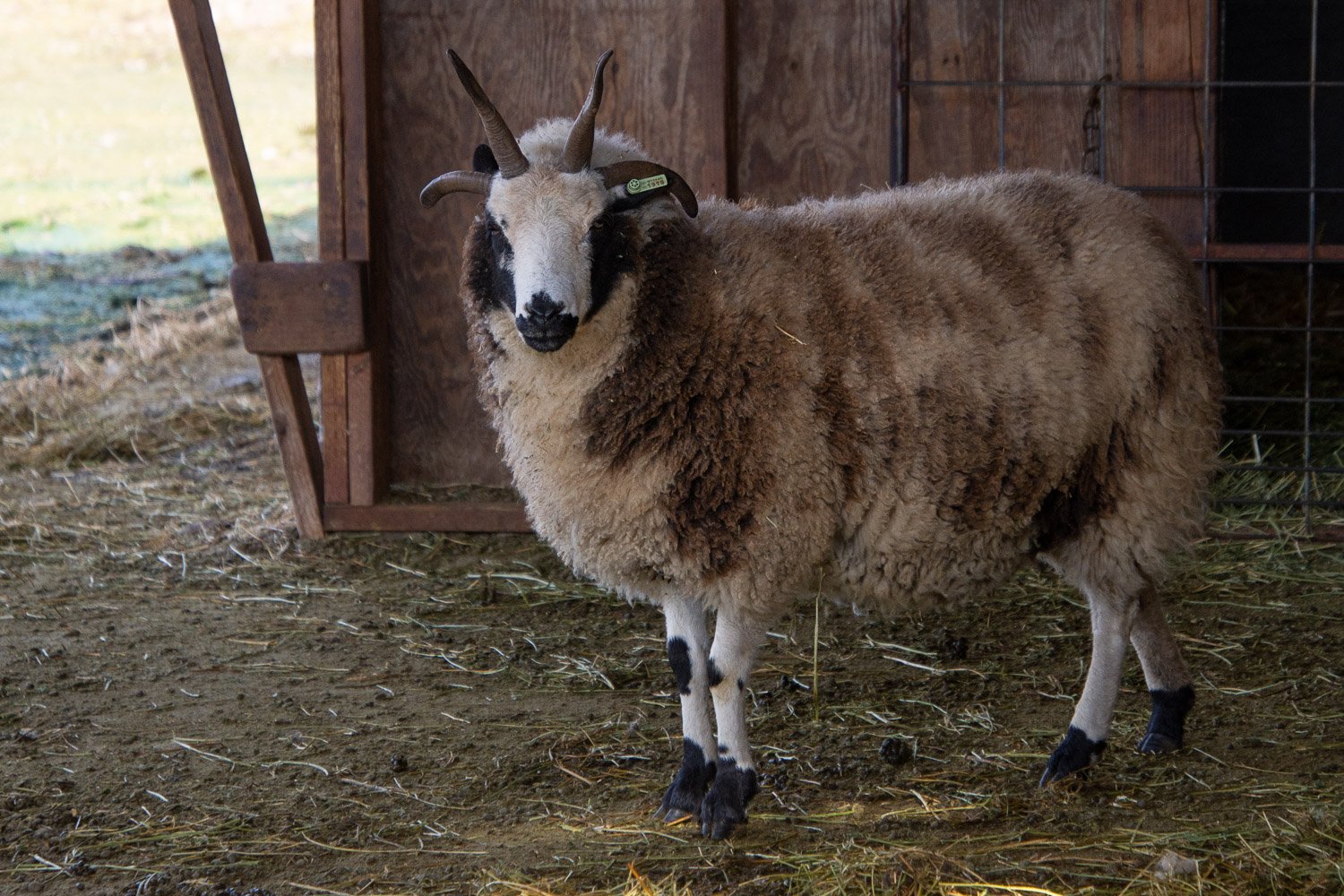
Sweetgrass Eilwen is Tranquility’s buddy.

Since I have gone off the original track to the sheep I bought this summer I thought I should be thorough. This is Hillside Gabby’s Barrett, a ram lamb who bred 7 or 8 ewes in October. I can’t wait for lambing!

Back to the home-grown sheep. This is Meridian Trina (Meridian Axle x Meridian Terri). You can see that her horns, although acceptable, are not as desirable. She is a 4-horn ewe with horns that are fused and therefore somewhat funky looking.

Trina’s dam is Meridian Terri, a ewe who also has fused horns on one side.

Look at Terri’s fleece. Isn’t that beautiful? It’s not all about the horns. There is a lot to try and get right with this breed.

Meridian Sonata is the oldest ewe here. She’ll be 10 when she lambs in March.

Meridian Sylvia is Sonata’s daughter. She has nice upper horns, but the lateral horns aren’t very stout. She was a ewe worth keeping though.

Soprano is another Sonata daughter. I don’t like putting coats on the sheep because I’d rather see the sheep than the coat (and it’s a lot of work to keep up with coats). But this fleece will be stunning because it will be so clean.
Maybe I’ll share more sheep photos tomorrow.
…With a new phone…or is it a camera? I don’t know that I NEEDED a new phone, but the camera intrigued me. My new iPhone was delivered a couple of days before Christmas but I waited until then so my son could make sure it was set up right. I haven’t taken time to put the camera through its paces until now. I started exploring it today Across the Road.

I took this while doing chores this morning—two Northern Mockingbirds on a fence wire.
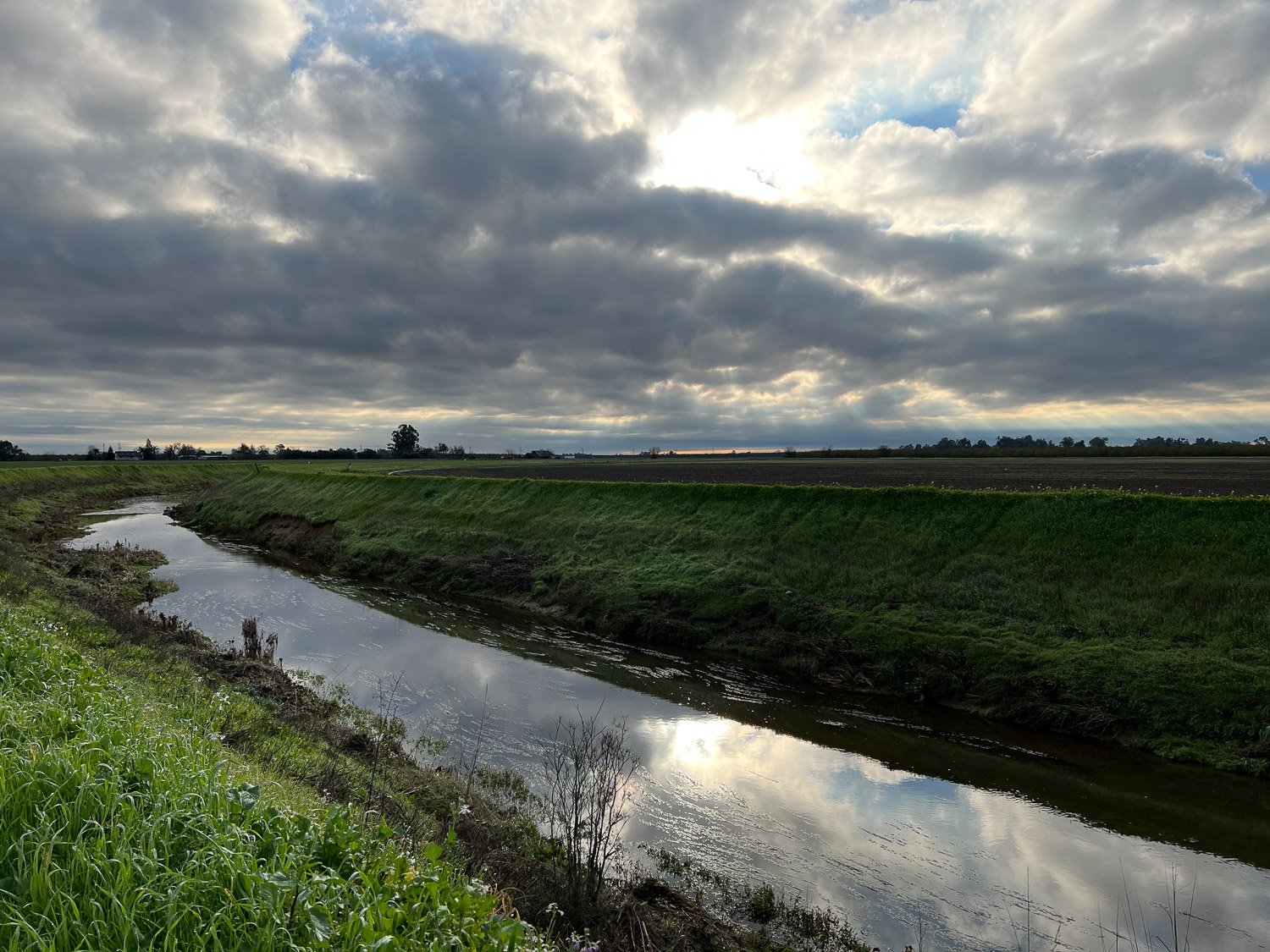
When I finished chores I took Ginny Across the Road. There was finally a day without fog. That’s one reason I haven’t been motivated to get out other than taking care of sheep—the fog has been so cold and drippy.

Today the clouds and filtered sun rays were inspiring.

The new camera can handle flower close-ups.

Dog close-ups too.
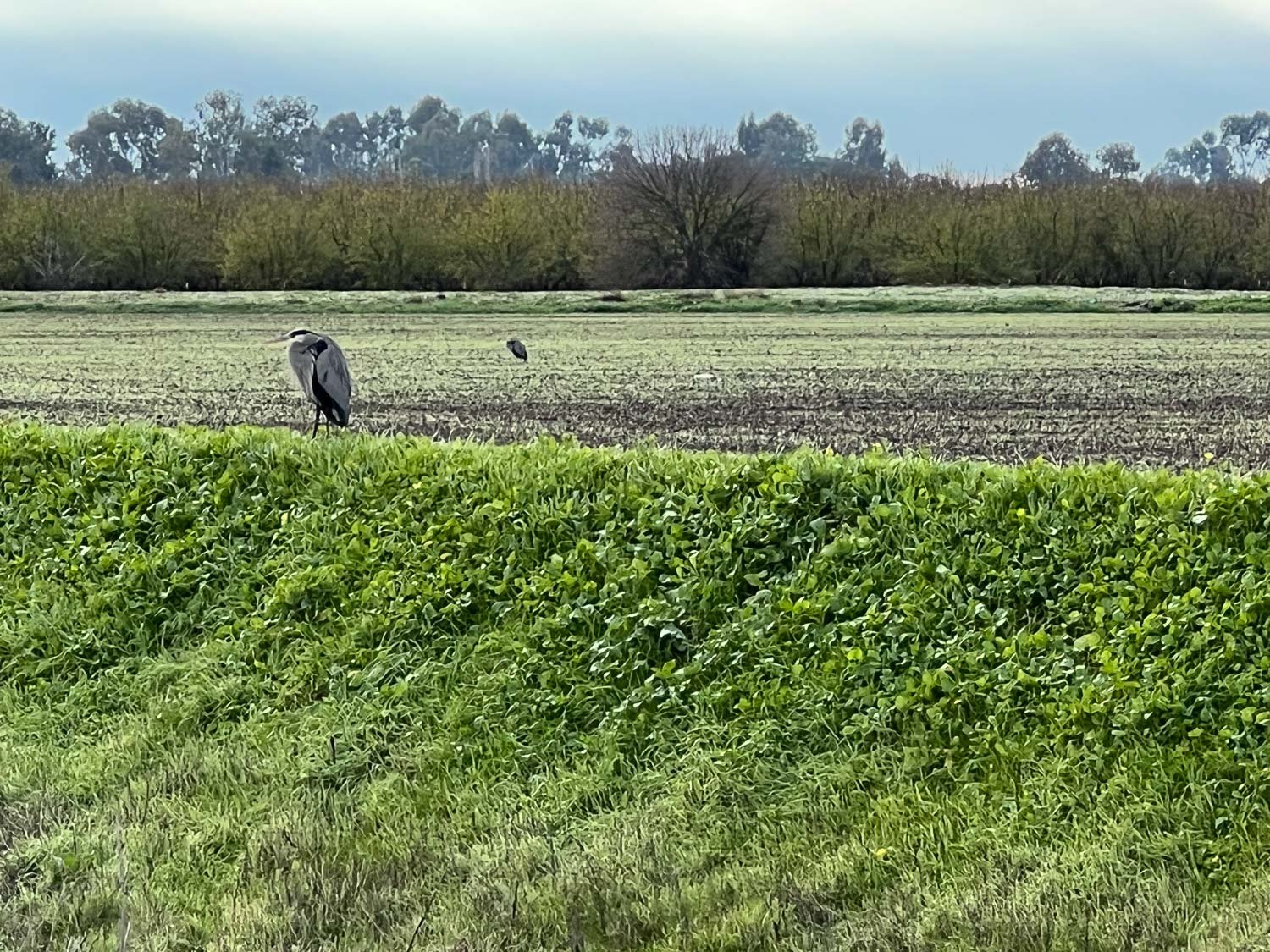
These great blue herons were still far away across the canal but I was surprised at how close I could bring them.

Ginny’s ball is just out of the photo on the left.

I wanted to go check out those white dots in the alfalfa field but, although the dirt road was hard packed enough to walk on, the field is far too muddy.
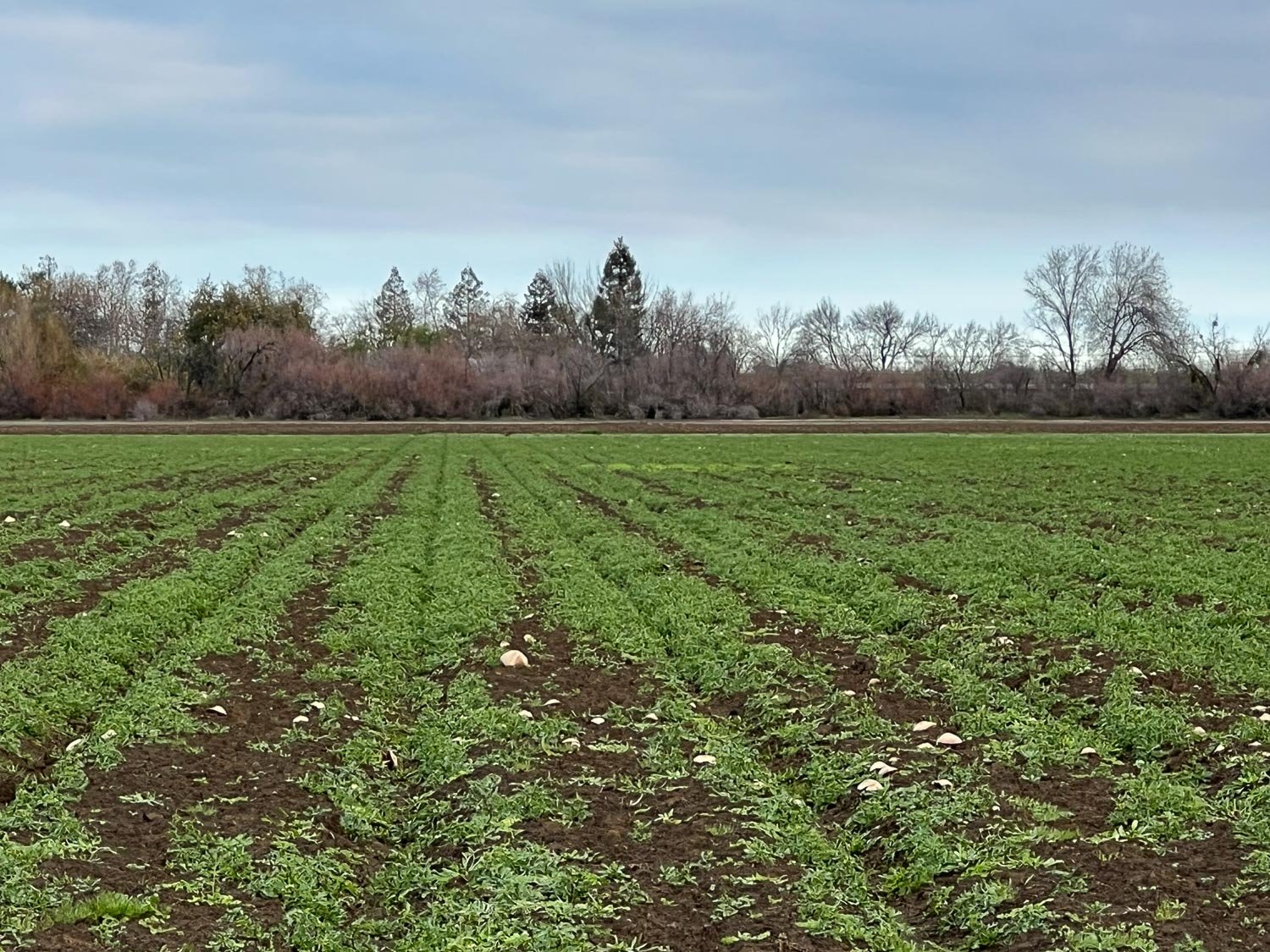
The camera did a good job of bringing the mushrooms closer.
I haven’t seen otters in a long time, but there was one today.
I had a couple of comments after the last post “A Ram Retrospective”. One person asked about Rotor. I couldn’t include all the rams I’ve ever had, but how could I forget Rotor?

Rotor had the unimaginable triumph of winning Supreme Champion Ram at the 2016 CA State Fair. That means the judge placed him over all the other breed champions. I don’t know what the talk in the barn was after that. Usually it’s one of the “regular” breeds that win.

This photo isn’t very sharp, but you get the feel of what the Supreme Champion competition looks like. Rotor and I are third from the left dwarfed by those huge rams, all perfectly fitted for the show. Jacob sheep are shown in a much more natural state, at least by those of us showing on the West Coast.

While I was looking for those last photos I came across this one. In the last blog there was a photo of Axle at almost three years and his horns had curled very close to his face. Axle was Breed Champion (Primitive Breeds) at the State Fair when he was a yearling.

At four months old his horns looked very promising. Many lambs are born with nice markings and good fleece, but a ram has to have horns that won’t impact his future well-being. With a two horn ram that means they need a nice wide spread.

Axle at 9 months.

Axle, almost three years. That horn on his right is getting pretty close to the jaw.
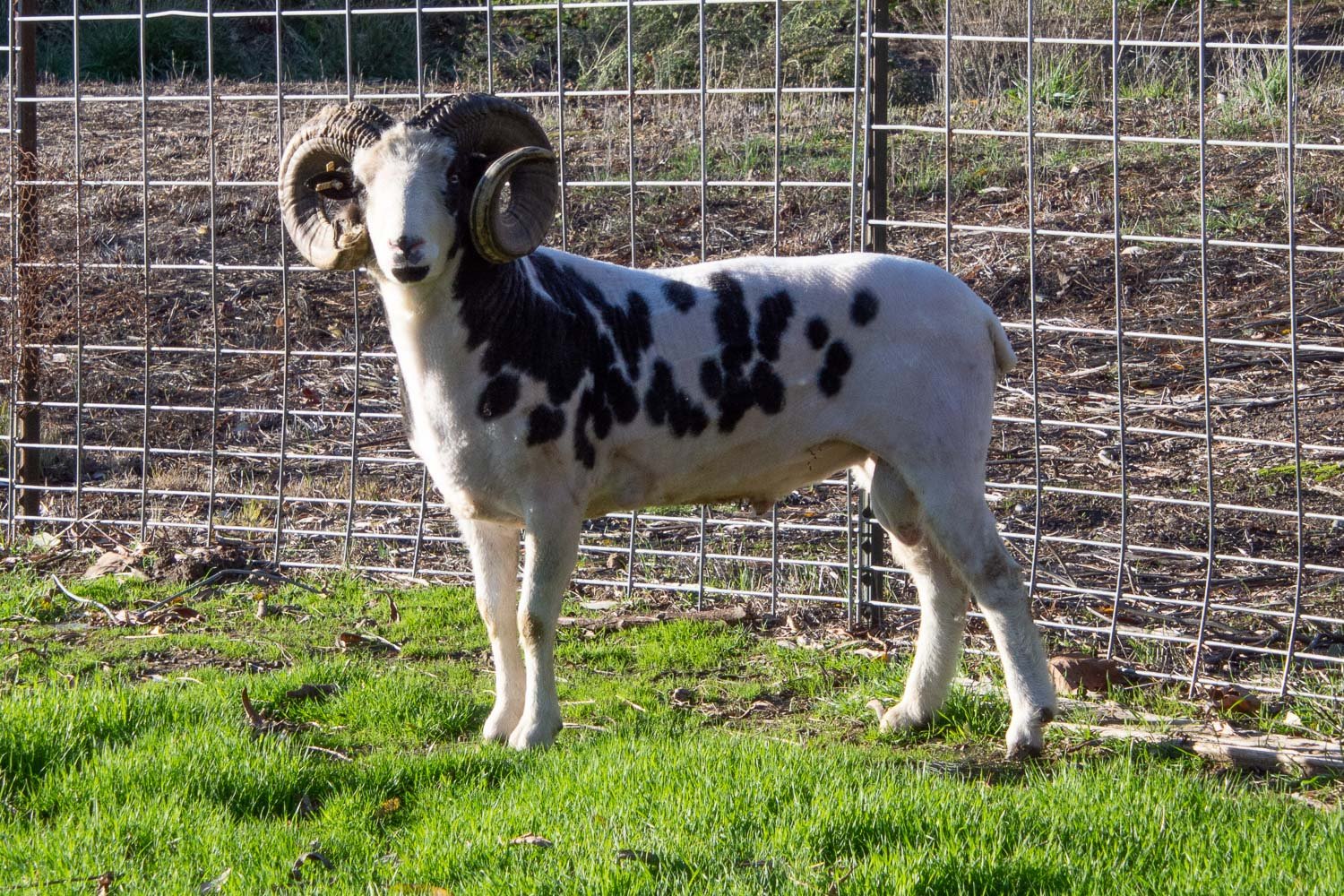
This photo was taken a few months after the last one. Axle has broken that right horn—I’m not sure how. Shortly after this he was sold to someone who was moving with her flock to Montana. Hopefully he is still there siring beautiful lambs.

I will remember Axle for the fun time we had at the 2019 Black Sheep Gathering Spinners Lead. I can’t imagine another of my rams standing so patiently on a halter with lots of other sheep around for the hour or so that we were lined up and waiting our turn. By the way, the scarves that he and I are wearing are his wool spun and woven that spring.
Axle has 7 or 8 offspring in the flock now.

Meridian Pecan…

and her twin Meridian Sandie.

Meridian Hazel, daughter of Axle and Jade, the most friendly sheep here. Hazel is #2 in line for scratches (and treats).
On Christmas Day I took advantage of my son being here to try and track down photos that seem to be “lost” in the depths of my computer. I’m still not sure we found the family photos I think are somewhere, but it prompted me to later go through other photos. I probably don’t really need all 33,000 that Lightroom says I have. There may be other posts like this one later, but I’ll start with rams. I think it’s always fun to see the variety in Jacob rams.

This is Jacquee’s Rugby. I think he might have been the first ram I bought, probably in 2001, because he sired lambs born in 2002 and 2003. I know I used a couple of other rams (from Hillside and Oak Farm) but I don’t find any photos of them. The photos here are of those I bought or that were born here.

Bide a wee Duke sired lambs in 2003 and 2004.

Meridian Apollo, born in 2004, sired lambs born in 2005 and 2006.

Hillside Joy’s Lynn, a lilac (the gray/brown coloration) ram who sired lambs born in 2005. By this time I was using at least two rams each breeding season and maybe more, but I don’t have photos of all of them.

Meridian Rocky (Meridian Apollo x Meridian Diamond) was born in 2006 but I don’t have a photo taken here. This was sent to me later by the person who eventually bought him. He sired Ranger, who is a few photos down.

Hillside Springtime’s Newberg sired lambs in 2007.

Bide a wee Yuri sired lambs born in 2008.

Chicory Lane Houdini was here for about half a year. He came to me because he had become aggressive and the owner needed him off the property. I used him for a breeding season and then didn’t want to risk the potential danger of keeping him around. This is an example of why I have very strong opinions about how rams should be handled while they are growing up.

As the flock grew Meridian Ranger (Meridian Rocky x Meridian Dot) sired a lot of lambs in 2008 and 2009.

Meridian Tioga was Ranger’s son, born in 2009. He sired a lot of the 2010 and 2011 lambs.

Puddleduck Ringo, born in 2014, is the sire of some ewes still in the flock, including everyone’s favorite pet, Jade.

Meridian Catalyst (Meridian Crosby x Meridian Clover) was a 2015 grandson of Yuri, in one of the photos above. Catalyst was a lilac ram who was eventually sold to another California breeder.

Bide a wee Buster, born in 2016, also sired many still in the flock.

Meridian Cayenne was the 2017 son of Catalyst and Mud Ranch’s Foxglove. He was that lilac color pattern with beautiful horns like his sire.

Meridian Jasper (Meridian Clark x Meridian Jade), is a grandson of both Buster and Ringo. He was born in 2019 and the sire of 6 or 7 sheep still in the flock. Jasper is now the flock sire of another California farm.

Meridan Axle (Meridian Catalyst x Meridian Ava) at almost 3 years. Axle was a favorite ram as far as his attitude and his fleece, and some of his offspring remain in the flock. I’ll share photos in another post of how fabulous his horns looked in his first year. This is an example of why you can’t always predict the final outcome of the horn growth. He is now at a farm in Montana but 5 of his offspring are here, including our second best pet sheep, Hazel.

Ruby Peak Tamarisk sired many of the 2021 lambs and we are awaiting more of his in 2022.
I went out for chores last night and was surprised to find this:

Of course it wasn’t in a pen with nice clean straw. I had no idea that there would be a lamb so I haven’t been watching for them.
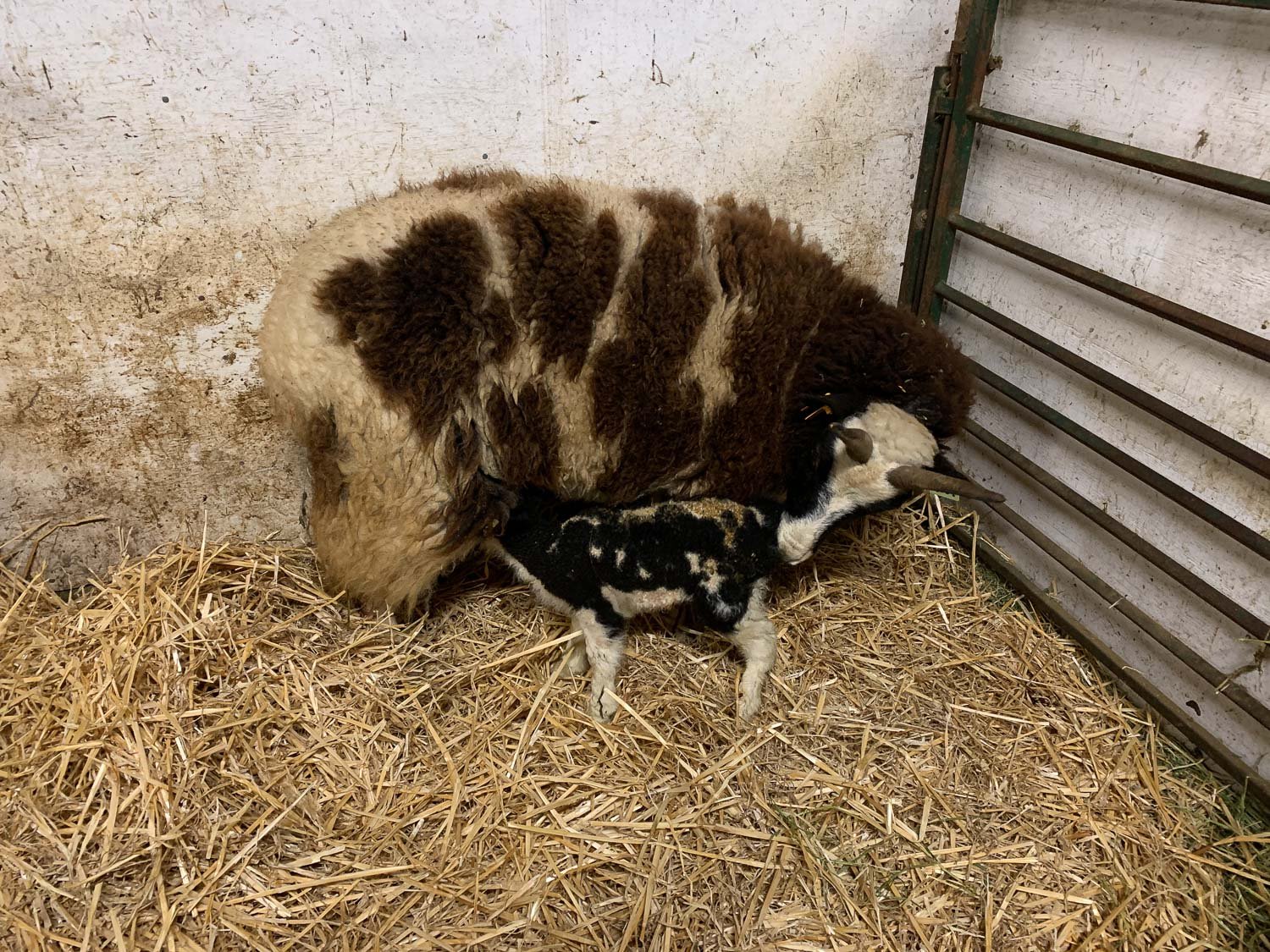
Lambs aren’t due until February 28. I checked back on my calendar 5 months and we were in Texas when this ewe would have been bred.

I checked with people who were here to find out if there were any break-outs (or break-ins) while we were gone and no one can think of anything. That means that I didn’t get all of the ram lambs out of the pasture when I had intended to. I meant to do it by the time they were four months old but I must have missed someone.

This ewe, Spice, is one of two ewes for whom I did not have a breeding date. The other has a fertility problem because she has never been bred and was confirmed open when we did ultrasounds a few weeks ago. The vets did ultrasounds on all the ewes and found 2 open that I thought would have been pregnant, but 52 other ewes that are pregnant.
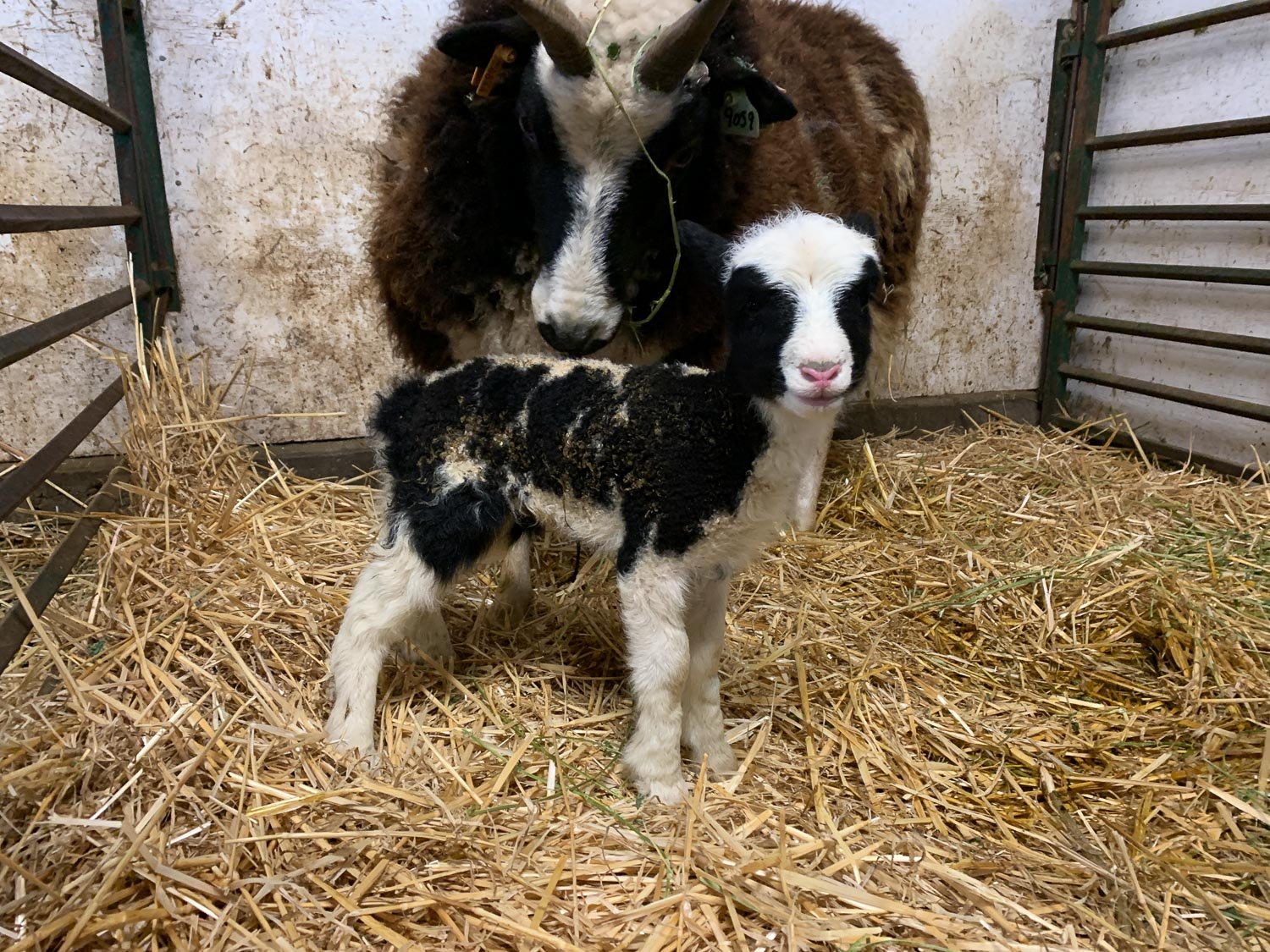
Farm Club members have suggested names: Yule and Surprise so far. I was wondering about OOPS!

After so many years of drought, maybe we’ll start to catch up. There is a lot of snow in the mountains and we got more rain yesterday. In the late October storm and this series of storms we have alsost more rainfall already than we got all last year. This photo is last night’s total. We had 3” a couple of days ago.

That much rain all at once makes for a mucky mess. Dan made a bridge for my wheelbarrow. This is why farmers don’t throw things away. That structure was one that has been around here for quite awhile—I think we may have got it from a friend when he moved years ago. It’s been the elevated path between the two houses since we had that October rain. Now it’s going to work as a bridge out here.

I looked at this view over the gate this morning and thought that the sheep looked very festive with their red and green markings.

One last photo. This was on Saturday as I was driving home from Sacramento. (Traffic was stopped so I as able to get this photo at no risk.)
In yesterday’s post I talked about trying to keep fleeces clean and mentioned the problem of the goats dropping hay on neighboring sheep. This morning I noticed this:

This is just what I mean about how goats eat.

Here is the other goat.

She turned her head to the side and dropped a big chunk of alfalfa on the sheep next to her.
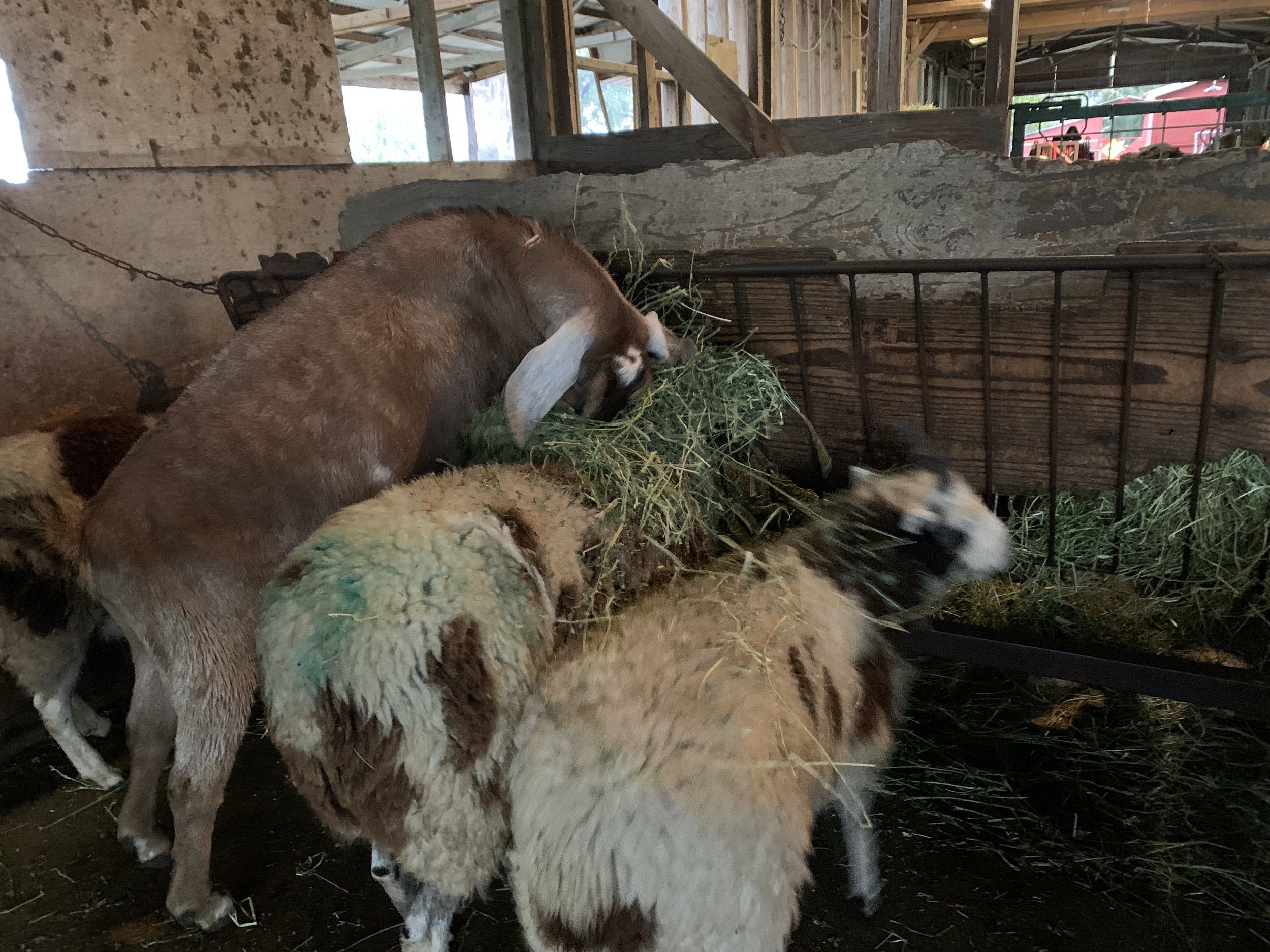
Not a good sight when I plan to shear soon.
I outsmarted the goats. They are now in another pen by themselves. I feel bad about that because they are not happy. But they have each other, there is plenty of room for two goats, and they won’t get into trouble. Maybe I’ll put the back with the sheep after shearing.
People always ask why some sheep have coats or covers. If you’re a spinner you know the answer. Spinners want to work with the cleanest wool possible. We’re not so worried about dust and dirt that accumulates from living outside. It’s the vegetable matter (known as VM) that is the problem. VM includes bits of alfalfa or grass hay in the fleeces of sheep fed in the barn or foxtails and other seedheads from pasture or range plants that have gone to seed. What do you know about seed dispersal? The most successful plants have developed means to get their seeds spread as far as possible. That often refers to foxtails or burrs or stickers that get caught in sheep fleece or your socks or your dogs’ fur. Washing does not remove VM. Some of it drops out with carding or combing, but much does not. In large (huge) commercial mills there are chemical processes to remove VM, but those are not available (or desirable) in our small and mid-size mills.
So how do we avoid contaminating fleeces?

KEEP HAY FROM DROPPING ON SHEEP. When I feed I chase them all out of the barn and close the gate. Then I put hay in the feeders before letting the sheep back in. At least that way I’m not dropping hay on sheep. Notice the wood panels in the feeders. The sheep feed from the base of the panels…EXCEPT for those sheep who insist on putting feet on the feeder and grabbing mouthfuls over the top. The goats do that all the time—grab a mouthful and then turn their heads and drop it on the nearest sheep. This is not a perfect system.

Coating sheep is another way to promote VM-free fleece. Some farmers who are well known for growing premium wool coat all their sheep. I choose a few to coat. It is usually those sheep that have been shown at a fair or fiber show. I use coats during transportation and at the show and then continue to coat them for the rest of the year. There have been no shows now for two years so I chose a few to coat anyway.
There are issues with coats. One is that I don’t like looking at coated sheep. I like the spots and the natural look of my sheep and that is how I’d rather see them. The other issue though is the amount of work involved. Not only do you need to change coats at least 3 or 4 times a year as the fleeces grow out, but there is a lot of coat maintenance, something that is worse when you have horned sheep. The coat on the sheep above is doing much good at this point.

Another problem coat. In this photo you can tell one of the benefits of coating sheep. The fleece maintains a darker color throughout because the tips aren’t sunbleached. This is a lilac sheep so her fleece is a brown color instead of black. You can tell the difference the coat makes by comparing the uncoated neck wool with what was under the coat that is now torn and dragging.

This is Quora, a ewe who will be two at her next shearing. The coat is not only torn but is getting too tight as the wool grows. This photo was from August of this year.

Here is how the fleece looks.

These are the coats I replaced earlier in the year. These have all been washed but now need to be repaired. I do not have an industrial sewing machine and a home machine can only do so much. I can sew rips and use patches, but it gets tricky when you have seams in multiple layers of thick fabric.

I changed four coats this morning. This is Quora, the ewe whose torn coat was replaced in August. This one is getting tight around the neck and is also torn.
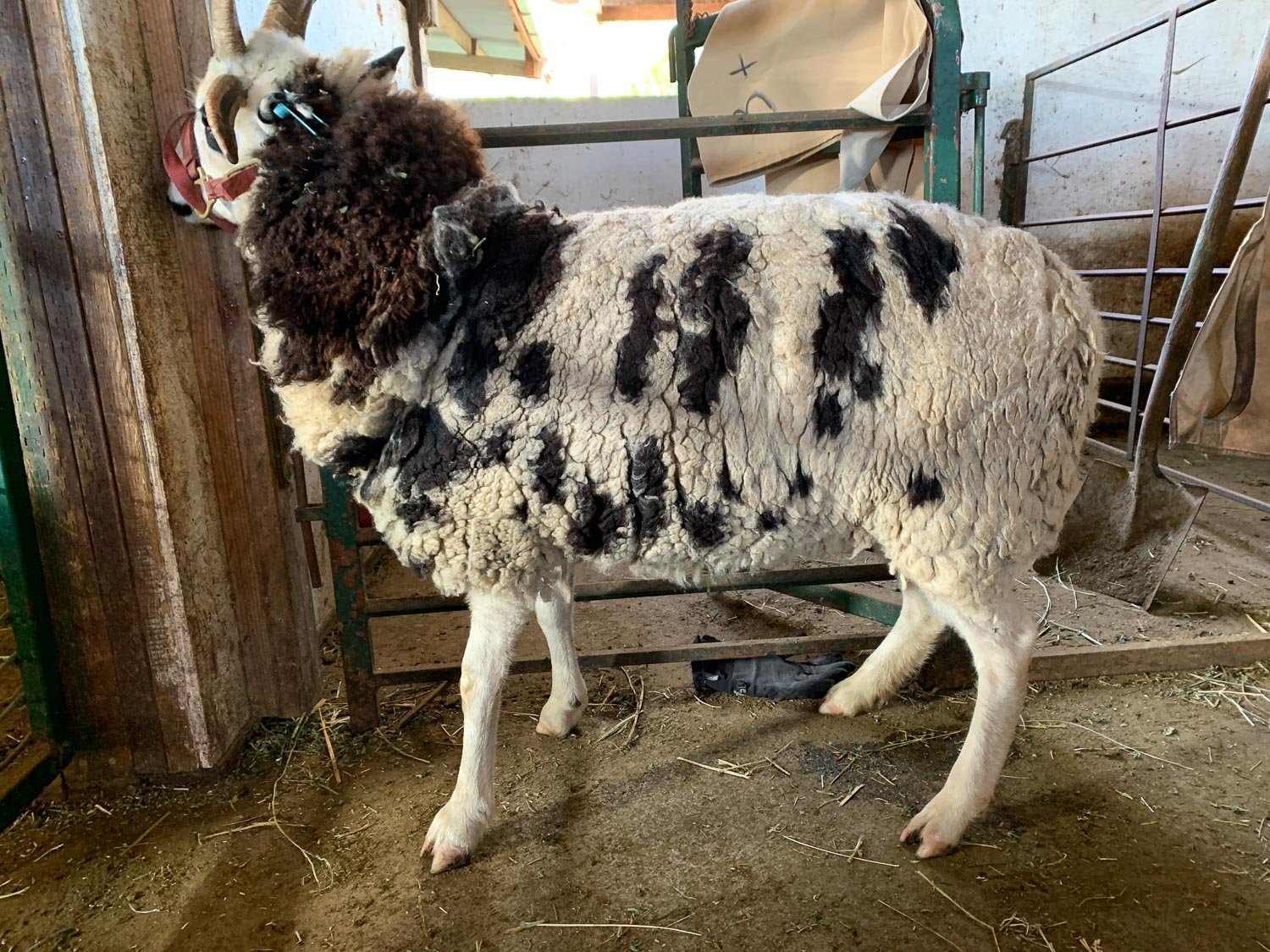
Notice the true black color where the coat was protecting the wool.

I may need to claim this fleece for myself.

Here’s the new coat—Size 4+ .

I don’t have a photo of this ewe, Pecan, before removing the coat but you can see from the neck and tail now tight that coat was on her. Pecan is another lilac ewe (that gray brown color instead of black).

Pecan’s fleece. Wait! Maybe I need to keep this one.

Pecan in her new coat—still sort of tight on that fleece. We have 7 weeks until shearing. Can this coat last?

This is Pecan’s twin, Sandie, with her coat removed. Her fleece is still in good shape, but when coats get too tight they can contribute to felting on the sheep.

Sandie’s fleece.

Sandie’s new coat.

Soprano’s coat wasn’t as tight as some of the others, but it definitely needs repair.

Soprano’s fleece.
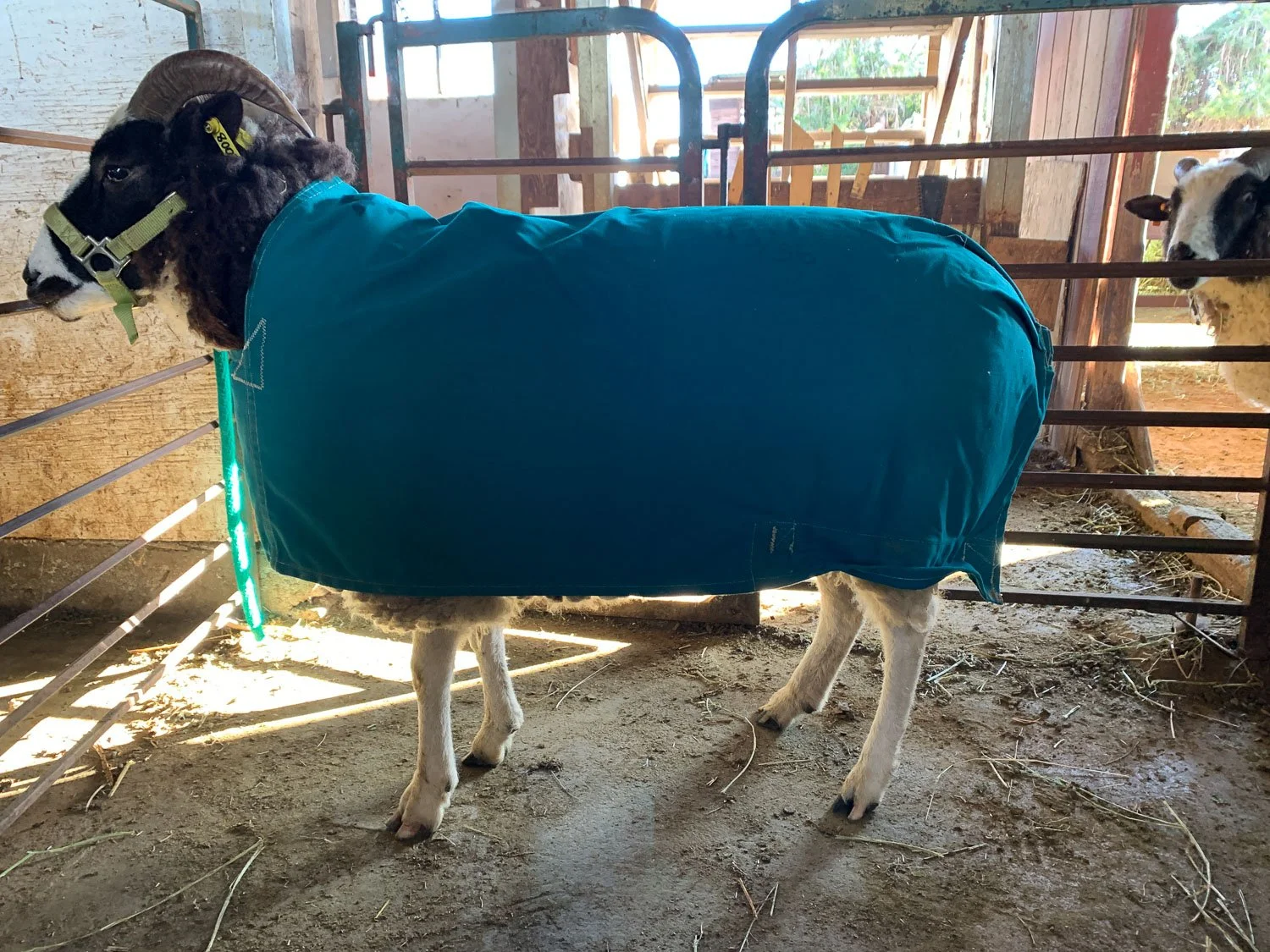
This coat is a better fit and has no repairs… yet.

These are the four ewes whose coats were changed today. I think there are two or three other coated sheep in the flock.
This title leaves the focus of this blog post wide open, but the intent is to share some of the steps in getting the yarn ready to sell. Never mind the part about raising the sheep, shearing the sheep, sorting the fleece, shipping the fleece, scouring, carding, and spinning. I’m starting with the stage where I get the yarn back from the mill. I divided my 2021 Jacob fiber into two batches. The first batch went to the Valley Oak Wool & Fiber Mill in Woodland and the second to Mendocino Wool & Fiber in Ukiah. The Valley Oak yarn has been back for awhile and is on my website here.

This is the yarn I got a couple of weeks ago from Mendocino. When I skirt and sort fleeces I first separate the coarser britch wool from the rest of the fleece. This is fiber that grows on the back leg of the Jacob sheep and it needs to be removed to keep the bulk of the fleece feeling soft and not scratchy. (More about this later.) Then I sort for color. In this case you can see the white and the black and two grays. Gray is mostly a mix of white and black fiber that isn’t realistic to sort. The lighter gray happens to be the britch wool that I don’t sort for color—the black and white mix together in whatever proportion I sorted out. The darker gray on the left is the blend of white and black fibers from the main part of the fleece.
Also notice that there are cones and skeins for each color. This is the exact same yarn, just different “packaging”.

When I get the yarn back my first step is to measure the yarn. Using a yarn gauge (for sale here) allows me to compare this yarn to other yarns and to make a judgement about sett (ends per inch) for weaving or about needle size if I was planning to knit with it. The yarn on the cone measures 17 wpi.

However the yarn in the skeins measures 15 wpi. How can this be? It’s the SAME yarn. It makes sense when you see how tightly the cones are wound. The yarn in the skeins has had a chance to relax and bloom a bit.

What about this one at 12 wpi? It’s also the SAME yarn. The difference is that it has been soaked in water and then air dried. The yarn blooms even more. The significance of this is that the end user needs to know about the final state of the yarn. If the user makes a project (weave, knit, crochet) based on the measurement of the coned yarn the finished piece will likely be more dense than anticipated. The yarn will bloom when the project is washed. When customers buy yarn in a regular yarn store they expect that yarn to be in its final state and they don’t plan to wash the yarn before using it. I have to choose how to sell this yarn. In this case I soaked and then dried the yarn before re-skeining and labeling it. The customer can be confident that the yarn is ready to use.

The three colors of the yarn are very similar in size, but I went through this process anyway. The black yarn on the cone measured 17 wpi.

Skeined but not washed—15 wpi.

Washed—12 wpi.

This is the britch wool. You can see some of the hairier fibers. This yarn is great for rugs, bags, table runners and placemats, and even blankets. It’s just not as good as the other yarn for next to the skin wear. This one measure 15 wpi for the coned yarn.

The washed britch wool measures 13 wpi.

This and the one below are the final product photos for the website.

You can find this yarn on the website or in person at the shop (hours are here).
I should share some projects from this yarn, but that will have to be the topic of another post.
At Meridian Jacobs farm we raise Jacob sheep and sell locally grown wool fiber, yarn, and handwoven goods. We teach fiber classes and sell Ashford, Clemes & Clemes, and Schacht spinning and weaving equipment. We encourage farm visits with field trips and our unique Farm Club.
Search blog posts since 2019. If the search says it can’t find a post try putting in your search word a second time. I don’t know why but the second time it seems to work.
Search the entire website, including older blog posts.